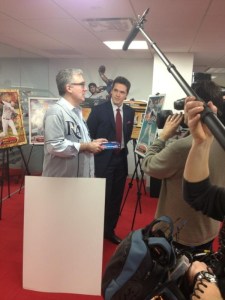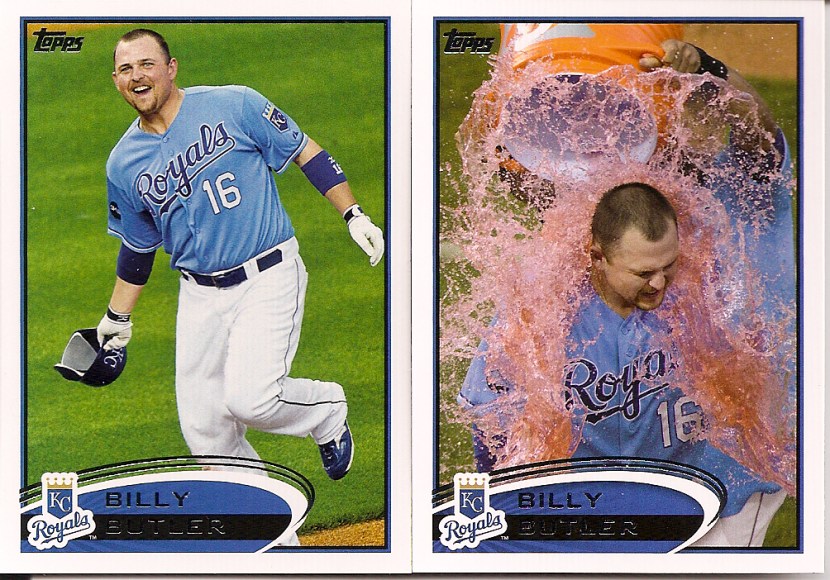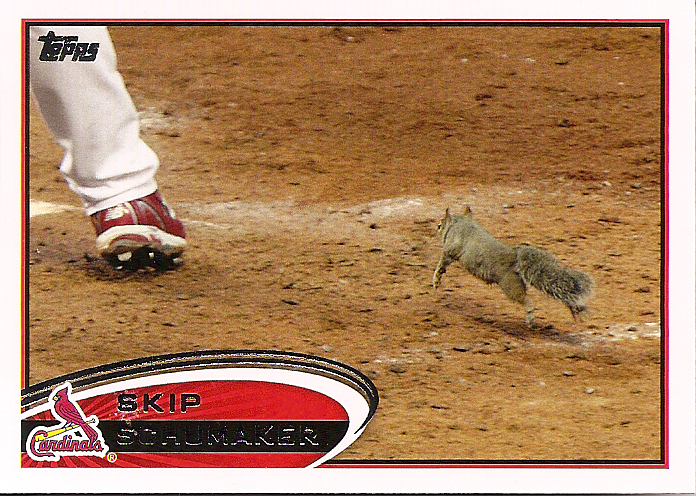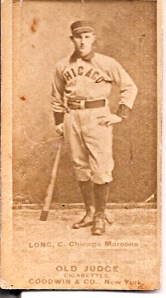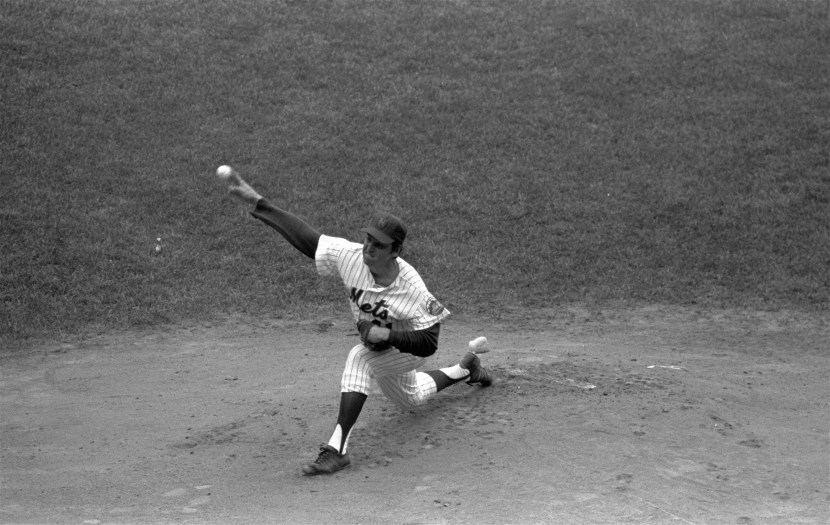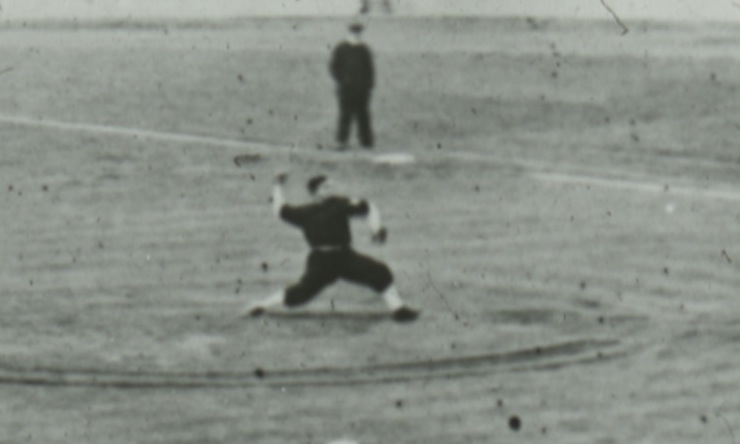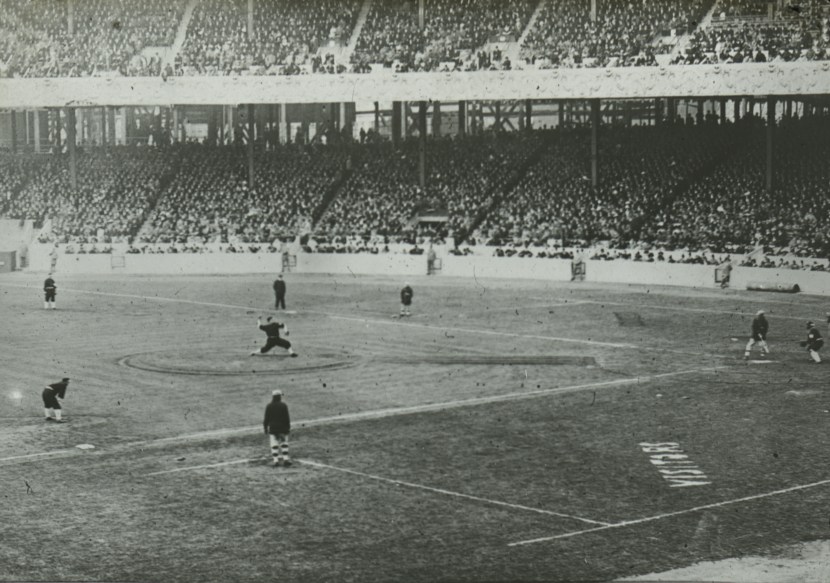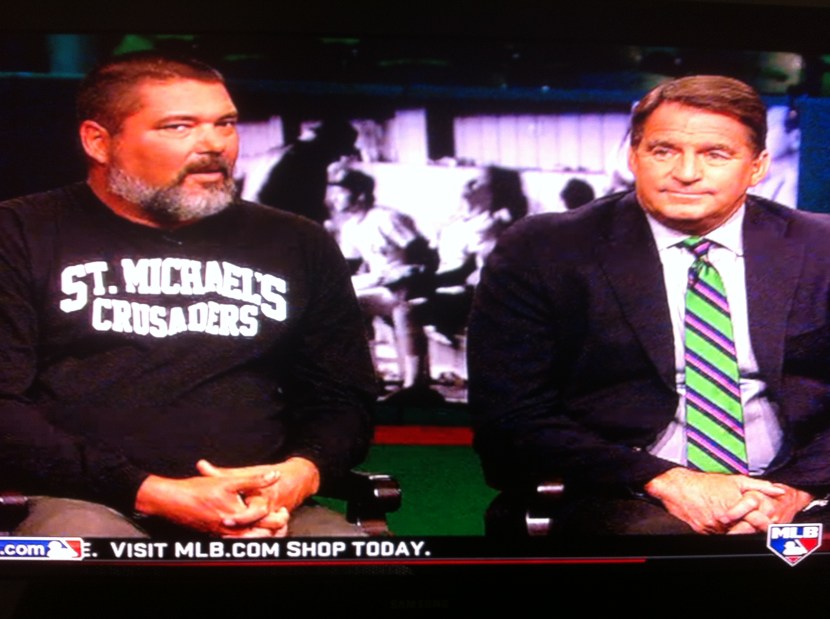Tagged: MLB Network
The Non-SABRmetric Argument Against Miguel Cabrera
It was my privilege to be part of this morning’s MLB Network Hot Stove roundtable on the real election of 2012 – Cabrera v. Trout (reairs at 4 PM ET if you’re reading this before then).
If you noticed the index cards in my hand, you’ll know that I offered a lot of data – not about VORP or WARP or BABIP or any of the new analytics – but essential hardcore boxscore stuff that undercuts the second biggest argument for Miguel Cabrera as American League MVP: That preference has to be given to the guy on the winning team, and that Cabrera ‘carried the Tigers on his back into the playoffs.
Firstly, the Tigers finished with only the seventh best record in the American League. That’s seventh out of fourteen. In the pre-division days they used to call that The Second Division – and it was a sign of shame. As it applies to this topic, there is also this embarrassing reality:
Angels (Trout’s team) 89 wins, 73 losses
Tigers (Cabrera’s team) 88 wins, 74 losses
The Angels, playing in a far tougher division, won more games than the Tigers did – yet any MVP doubt is supposed to fall on Cabrera’s side because he was on “the winner?”
It doesn’t make sense – it’s a remnant of the days when only one team per league made the “post-season” – and it wasn’t Cabrera who won the AL Central, it was Cabrera and the rest of the Detroit team –but I’ll just concede it to Cabrera’s supporters.
What I will not concede is this assumption that Cabrera deserves the MVP over Trout because, since the Tigers made the playoffs, he was necessarily more valuable – especially as the Tigers managed to sneak past the collapsing White Sox ‘down the stretch.’ One of the cards I didn’t get to fully reveal on the show suggests Cabrera was hardly repeating the Carl Yastrzemski feat of 1967 over the last two weeks of the season.
After the games of September 18, the Tigers were two games behind Chicago. The remainder of the season gives us a small but insight-filled sample of what Cabrera did – and what he didn’t do – over the last 15 games.
CABRERA, AFTER 9/18/12:
Games: 15
Average: .291 (16/55)
Homers: 4
RBI: 10
BB: 3
It should be noted that three of Cabrera’s RBI came in one game – on September 29 – and two others came on October 2. So he drove in runs in seven of the Tigers’ 15 stretch games.
And there’s a fascinating statistic from those games. The Tigers only won four of them. In other words, they were 4-and-3 when Cabrera drove in runs in a game…and 6-and-2 when he didn’t.
More confusing to the Cabrera “Pennant-Winner” meme, is Detroit’s record when other Tigers drove in runs in those final fifteen games:
TIGERS RECORD WITH RBI BY…
Prince Fielder 6-1
Alex Avila 4-0
Jhonny Peralta 4-0
Austin Jackson 4-1
Delmon Young 4-1
Andy Dirks 3-1
Miguel Cabrera 4-3
But…those RBI in those four games won those games, right? The MVP surely did something essential in the most essential of simple stats, down the stretch, right?
Not really, no.
This is from a card I was in the middle of reading when Chris Russo cut me off. He had reason to do so.
CABRERA RBI AFTER 9/18/12, DETAILS:
1. 9/19: Tigers leading 4-0 in 7th when Cabrera hits solo HR (6-2 win)
2. 9/22: Tigers leading 7-0 in 4th when Cabrera hits solo HR (8-0 win)
3. 9/23 (1st Game): Scoreless in 4th: Cabrera RBI 2B produces 1-0 lead (10-4 loss)
4. 9/23 (2nd Game): Scoreless in 1st: Cabrera RBI 2B produces 1-0 lead (2-1 loss)
5, 6, 7. 9/29: Tigers leading 2-0 in 7th when Cabrera hits three-run HR (6-4 win)
8. 10/1: Tigers leading 1-0 in 6th when Cabrera hits solo HR (6-3 win)
9, 10. 10/2: Tigers losing 1-0 in 3rd when Cabrera 2-RBI 2B produces 2-1 lead (4-2 loss)
I’d grade the actual game situations in which Cabrera produced as ‘tepid.’ Two of his RBI (and half of his homers) were clearly unnecessary tack-on runs. His three-run blast on September 29th would prove necessary when the Tiger bullpen melted down; the solo job on October 1st might have been necessary – hindsight can’t give us a clear answer. On the other hand, the drove in the first run in both games on September 23rd, and his double wiped out a one-run deficit on October 2nd – and that the Tigers blew all three of those games should not subtract from the clutchness (clutchiness?) of those hits.
My point in here is not to dismiss what Cabrera did for the Tigers as the White Sox plummeted past them. There are countless fielding plays, runner advancements, and just his presence in the lineup to consider as “clutch” contributions. But the RBI-by-RBI examination proves conclusively that Miguel Cabrera did not carry the Tigers on his back down the stretch. He was not the slam-dunk MVP of his own team at the team it mattered the most. Without fine-toothed comb examinations of each game it’s hard to say who was, though the superficial data suggests it was Fielder.
I’ve already gone on at length about why I don’t think the Triple Crown matters in MVP voting (it’s outdated analytics, as dangerously misleading as if we based the voting on the first set of statistics that were so popular pre-1871, which was a ratio of Runs Scored to Outs Made). But I added one bit of research that underscores Rob Neyer’s point that if you have a Triple Crown, it usually means that a lower-than-normal average or homer or RBI total has proved to lead the league in what can only be described as a happy anomaly:
LOWEST AVERAGES TO LEAD AMERICAN LEAGUE SINCE THE INTRODUCTION OF THE DESIGNATED HITTER IN 1973:
.326 Bill Mueller, Boston, 2003
.328 Joe Mauer, Minnesota, 2008
.329 George Brett, Kansas City, 1990
.330 Miguel Cabrera, Detroit, 2012
.331 Michael Young, Texas, 2005
Cabrera won the Triple Crown – in part – because batting average was way lower than usual, and he produced the fourth lowest average among the last 40 A.L. batting champions during a year in which he had terrific homer and RBI numbers.
So you don’t have to go to WARP or VORP or VOR-WARP to deflate the Cabrera MVP qualifications. Good old-fashioned numbers and easy to read details can do it for you.
Oh, by the way, about clutch? During that same post-9/18 time, Trout went 16/52 (.308) with three homers, six RBI, and ten walks. Moreover, after August 19th, as the rest of the Angels made their feeble attempt to stay alive in the West, they were unbeaten…in games in which Mike Trout drove in runs.
10th Annual Topps Pack Opening Day
For years, as part of my moonlighting as an unpaid consultant for Topps Baseball Cards, I have engaged in a ritual involving a few company executives and a few (brand new) boxes of that year’s Topps set. The first box to come off the production line is ceremonially opened, either on television or at Topps HQ, and then we quietly pillage through whatever’s available pack-wise.
Today we turned it into a happening.
This started when I ran into my colleague and fellow collector Greg Amsinger at MLB Network two weeks ago. Greg is giddy enough about cards that I once almost distracted him from a Yankee Stadium live shot by advising him that my collection included three Honus Wagners. When the Topps gang and I set the “ripping of the first packs” for today, I asked if I could invite Greg along.
Ka-boom.
Greg brought a camera crew, Topps put up a display including blowups of the cards of Pujols and Reyes in their new unis and the one-of-a-kind gold card inserts, they assembled the entire 2012 Baseball Production team, I dressed up in my Matt Moore First Win Game-Used uniform, they fitted up a conference room full of unopened boxes, and pizza, and I had to give a little speech, and half of the staff snapped photos on their phones and their tweets out even before I finished talking (insert your own joke here; I actually had to be brief for a change as I’m still under doctor’s orders to not try to ‘project’ with some severely strained vocal cords and throat muscles).
Suddenly we went from four guys sitting in a room going “nice shot of Braun” to a veritable orgy of pack opening. It felt like snack time at Willy Wonka’s Chocolate Factory and I must say, for something that was made ‘bigger’ than in years past at least in part to utilize the presence of a tv camera, this organically and spontaneously turned into a really fun ninety minutes in which the pride of the employees – to say nothing of the imminent promise of spring and another MLB season – were in full bloom.
Before we get inside the packs, and a really exceptional effort by Topps this year (to say nothing of a sneak peek at their next issue, 2012 Heritage) a couple of fun images.
The Topps production team all signed the first box that was part of the ceremonial presentation depicted above. They do it at aircraft factories and they do it on the first production runs at Apple – so why not? And on the right is that display I referenced complete with the Pujols and Reyes blow-ups. I have no idea how poor Amsinger, Cardinal diehard that he is, got past this graphic testament to the fact that Albert has surrendered his legacy in St. Louis and is now tempting the curse of Almost Every Angel Free Agent Contract Ever (Amsinger, when I pulled a Mark Trumbo card today: “It should say third base on his card. Where else is he going to play for them?” Me: “First. After you-know-what happens.” Amsinger: shakes head dolefully).
Over the last few years, Topps has been steadily improving the photo quality of their base set, but this year a great leap has been made. The photos are better sized and framed, more interesting, more innovative, and with the ever-increasing improvements in the mechanics of photography, crisper and more compelling. The embossing makes the names difficult to scan but the shots here of David Robertson and Jose Altuve are really terrific and virtually every square quarter-inch of the card frame is filled and filled cleanly. There’s a design decision here, visible in the Altuve card, to sacrifice the tip of his left foot to minimize dead space – and I think it works wonderfully.
And then come the fun cards. There are SP’s (single prints, if you’re not a collector – cards that you know going in are much scarcer than the regular 330 cards) that include Reyes and Pujols sent by the magic of computers into their new uniforms. When you consider that as late as 1990 Topps was still airbrushing the caps of traded players – literally hand-painting logos over the original one, not on a photograph, but on a negative measuring 2-1/2 x 3-1/2 inches) – let’s give the computer a round of applause.
computers into their new uniforms. When you consider that as late as 1990 Topps was still airbrushing the caps of traded players – literally hand-painting logos over the original one, not on a photograph, but on a negative measuring 2-1/2 x 3-1/2 inches) – let’s give the computer a round of applause.
The flatfootedness in the Reyes card makes it a little clunky but it gives you a pre-Spring Training hint at how the new Miami uniforms are going to visually ‘feel’ once the rechristened club takes the field.
Two years ago the theme of the SP’s were the Pie-In-The-Face celebrations, mostly enacted by the Yankees’ A.J. Burnett. This year the premise is celebrations and mascots, and in the case of the former, particularly the Gatorade Bath:
Butler, caught just as the orange goop explodes but before he’s lost under it, is a classic card. But, to my mind, the SP version of Mike Morse’s card 165 and its suspension-of-the-wave is an instant All-Time Great:
But 48 hours after the cards reached dealers and collectors, most of the publicity has surrounded the short print of #93 Skip Schumaker.
The Cardinals’ second baseman is said to be ticked off – and I happened to see Kevin Millar, serious for the first time in months, take unnecessary umbrage at the St. Louis Rally Squirrel squeezing Schumaker  out of frame – but remember, for every one of those cards, there are several hundred of the regular one on the right here. Happy? Nice boring five-cent card compared to one that’s rather crazily being bid up to more than $200 on eBay?
out of frame – but remember, for every one of those cards, there are several hundred of the regular one on the right here. Happy? Nice boring five-cent card compared to one that’s rather crazily being bid up to more than $200 on eBay?
Players take the baseball card photo a lot more seriously than they would have you believe. Several inscribe cards bearing particularly unflattering pictures with notations about how much they hate the photo. On occasion players won’t even sign their cards based solely on the choice of image.
The real trick for the Schumaker SP 93 will be not to get the player to sign it – he’s noted for a good heart, I’m sure the charity possibilities will be raised to him and he’ll sign a bunch. The problem is going to be getting that Squirrel to sign the card. Incidentally, the squirrel isn’t a Topps first; a card of “Paulie Walnuts,” a squirrel who occupied a foul pole at Yankee Stadium, was issued in 2007.
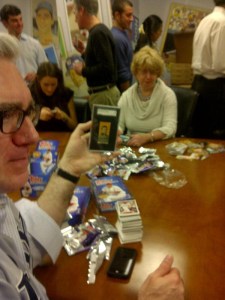
 I promised a preview of Topps Heritage 2012 and that’s coming – but one more aside first. I thought I’d pay off the day I scared Greg Amsinger with my Wagner boastfulness by bringing the famed T206 scarcity to Topps to link up the past and the present. He didn’t know it was coming, which is why he’s been caught mid facepalm on the right.
I promised a preview of Topps Heritage 2012 and that’s coming – but one more aside first. I thought I’d pay off the day I scared Greg Amsinger with my Wagner boastfulness by bringing the famed T206 scarcity to Topps to link up the past and the present. He didn’t know it was coming, which is why he’s been caught mid facepalm on the right.
And lastly, Heritage. They’ve done another meticulous job matching up the set celebrating its 50th anniversary, the vibrant 1963 design, in which the glowing colors of ’60s Topps were first evident: 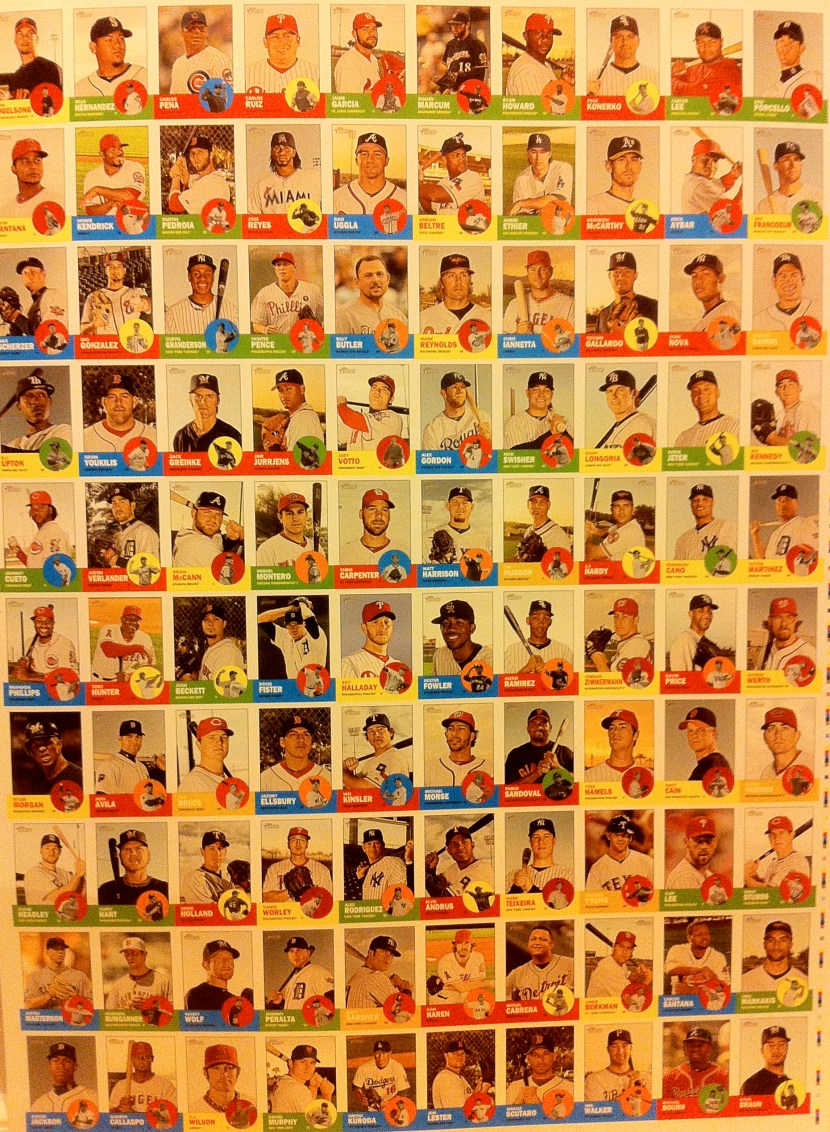 A lot of star players on this sheet – and forgive the waviness of the photo: it’s a sheet.
A lot of star players on this sheet – and forgive the waviness of the photo: it’s a sheet.
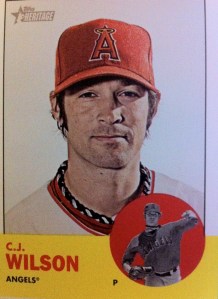
 Two cards in particular jumped out at me: Reyes again in what looks like a photo actually shot at the news conference announcing his move to Miami (although that could easily be a little misdirection) and C.J. Wilson in Angel garb.
Two cards in particular jumped out at me: Reyes again in what looks like a photo actually shot at the news conference announcing his move to Miami (although that could easily be a little misdirection) and C.J. Wilson in Angel garb.
One note on deadlines: Chris Iannetta is shown with the Rockies in the Topps set, but has already been updated to his new Angels’ uniform in the Heritage issue.
Name Dropping Herman Long
Had the pleasure of joining Brian Kenny on MLB Network’s Clubhouse Confidential yesterday (more on that below) and as we batted back and forth the necessity of electing Gil Hodges to the Hall of Fame, Brian mentioned that if he gave me a chance I could drop a lot of 19th Century Cooperstown-worthy players. I had time to say only “look up Herman Long.”
I’ll detail his Hall credentials in a moment. But first: for all of the weird HOF elections of the first 75 years, he is in the middle of the weirdest. Take a look at the results from the first-ever Veterans’ Committee vote, conducted in 1936:
- Buck Ewing 39.5 Votes, Elected 1939
- Cap Anson 39.5 Votes, Elected 1939
- Wee Willie Keeler 33 Votes, Elected 1939
- Cy Young 32.5 Votes, Elected 1937
- Ed Delahanty 21.5 Votes, Elected 1945
- John McGraw 17 Votes, Elected 1937
- Old Hoss Radbourn 16 Votes, Elected 1939
- Herman Long 15.5 Votes
- King Kelly 15 Votes, Elected 1945
- Amos Rusie 11.5 Votes, Elected 1977
- Hughie Jennings 11 Votes, Elected 1945
- Fred Clarke 9 Votes, Elected 1945
- Jimmy Collins 8 Votes, Elected 1945
- Charles Comiskey 6 Votes, Elected 1939
- George Wright 6 Votes, Elected 1937
So there were 78 ballots, 60 different players got votes, half of them eventually wound up in the Hall, but the guy who got the eighth most, who finished ahead of 23 future Hall of Famers, not only never made it but never again got significant support? I mean, in the 1937 Veterans’ Committee ballot, Long got one vote.
Something is very, very strange here. I mean, while we think of the stars of the 19th Century and the early 20th as having played in some kind of baseball version of the Pleistocene era, consider who the 1936 voters were. If this were January, 1936, Bob Costas would’ve made his NBC baseball debut in 1907, I would’ve covered my first World Series in 1900, Peter Gammons would’ve broken in with The Boston Globe in 1893, and Tim McCarver would’ve started with the St. Louis Cardinals in 1883.
In short, the 78 members of the Veterans Committee of 1936 saw most of the antediluvian names on that ballot play either professionally or as kids (let’s just play with that again: if this were 1936 I’d have seen my first MLB game in 1891 and I believe Peter’s first would’ve been in 1882). These guys thought of Herman Long in the same breath with the most famous player of the 19th Century (King Kelly), the man who won 59 games in one season (Hoss Radbourn), and the man who played or managed 14 pennant winners (John McGraw). For further context, there were six players to whom the first Veterans voters gave exactly one vote each, who wound up in Cooperstown and to some degree in the baseball public’s awareness, like 342-game winner Tim Keefe and the inventor of the curveball Candy Cummings. And Herman Long got 15 times as many votes.
So who was this guy?
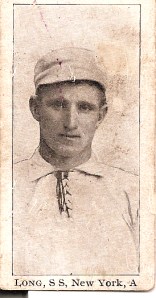
Derek Jeter is the Yankee shortstop now, but Long was the first. His 1903 Breisch-Williams baseball card; the photo shows him from Boston circa 1899
Herman Long was the great shortstop of the Boston Beaneaters’ dynasty of the 1890’s. He produced four consecutive years of an OPS of .800 or higher, had two 100-RBI seasons, six 100-Run seasons, and in a time without home runs, he hit 91 of them over 13 seasons including a dozen in each of two years. He stole 537 bases (that’s still 30th all-time) and scored 1,456 runs (77th all-time). In that measure of what an individual player’s offense and defense was “worth” to his team, “WAR,” Long finished with 44.6 (his Hall of Fame teammate, third baseman Jimmy Collins, finished at 53, and his Hall of Fame teammate, centerfielder Tommy McCarthy, finished at just 19). And despite having made more errors than anybody else in history, he has the 122nd best Defensive WAR+ among all position players ever. Boston’s two spurts – at the beginning and end of the 1890’s – produced five pennants and Long was the shortstop on all of the teams.
His nickname was “The Flying Dutchman.” When they began to use it late in the 1890’s for a kid named Honus Wagner, it was a tribute to Herman Long. More trivially, he would later play only 22 games there, but he was the first shortstop of the New York Yankees (then the Highlanders).
Is Long a Hall of Famer? I’m not sure. But he was considered the 8th best player among the “Old Timers” in 1936, and then fell into a black hole. It wasn’t even a matter of public scandal or diminished rotation – Long had been dead since 1909. He certainly merits consideration.
Remind me to tell you later about Bobby Mathews.
SPEAKING OF OLD TIMERS
Returning to the topic of my visit to MLB Network, if you didn’t know, that’s where my erstwhile employers MSNBC were headquartered from 1996 until October, 2007. I worked in this very building from September of ’97 through December of ’98, and then again from February of ’03 until we moved out. Yesterday was my first day back and it was mind-blowing. Baseball invested a reported $54,000,000 to upgrade the facility with rebuilt studios and state-of-the-art technology.
But they changed almost nothing else.
Not the carpets. Not the desks. Not the chairs. Not the make-up rooms. Not the cubicles. Not where the large clusters of desks are. Not the cafeteria. Not the offices. Not the office door plates. Not the “Employees Must Wash Hands” signs in the bathrooms.
Going into it was like one of those dreams you’ve probably had where you walk into some place totally familiar to you – your childhood home, or where you live now, or go to work, or school – and in the middle of it your unconscious has placed a nuclear reactor or a jungle or something else utterly incongruous, without changing even one other thing.
You think I’m kidding? My old offices, the one from 2003 and the one from 1997, are still offices, with the same doors, windows, nameplates, and televisions. The newer of them is occupied by an old colleague of mine from Fox Sports named Mike Konner, and to my amazement I found that on what is now his wall was a poster from MSNBC’s 2004 Campaign Coverage. I remembered this one distinctly, because there was controversy over some of the people shown in the back row (somebody wasn’t under contract, or somebody was left out, or something), and the thing was immediately replaced by a revised version with somebody else’s body swapped in. As I saw it hanging on Mike’s wall I remembered I had left the rare “uncorrected” version in a pile of junk when I left.
So why was it on Konner’s wall? I asked Mike where he found it. “It was here when we moved in. In a pile of junk.”
Every time I think of him saying that, I laugh. The poster has been in that tiny office since 2004. 
Seaver And Mathewson
On his MLB Network program Studio 42, Bob Costas tonight referenced a blog post here from 2009, and asked Tom Seaver if he was aware that I’d found a game-action photograph of Christy Mathewson from the 1911 World Series that showed Mathewson using the exact of drop-and-drive delivery Seaver brought to perfection in the early years of his career in the late ’60s.
Seaver said he’d seen the photo – I was pretty sure he had, since I’d sent a copy to him via a friend shortly after I found it in Cooperstown.
In blog years, a long time has passed since I posted the shots, so here they are again:
That’s Seaver – coincidentally in action against at Shea Stadium the San Francisco Giants in 1975 – showing the “drop and drive” that usually left the front of his right knee dirty. There had been a lot of anecdotal evidence that Mathewson, who retired in 1916, had used a similar delivery. But until the kind curators at the Hall photo archive let me look at their collection of glass images from the 1911 World Series, I don’t think anybody had actually seen a game-action image of Mathewson.
The resemblance, as you’ll see, is startling:
It’s the same delivery. In 1911.
Needless to say, I geeked out completely when I saw that photo. I literally thought “Why is there a picture of Tom Seaver pitching in the 1911 World Series?” After I posted the shot in August, 2009, I ran into Bob at Yankee Stadium and he had seen the post and he geeked out completely over it.
Just for the record, there are precious few game-action photos, particularly of pitchers, particularly in post-season action, from before the first World War. This was part of a series of 30 or 40 transparent glass slides, above three by five inches, that had been taken with a special camera for presentation as a slide show at the earlier movie theaters of the time. The Hall has what appears to be a complete set, and it constitutes a treasure trove for historians. You’ve heard of “Home Run” Baker? He got his name not for volume of homers, but for consecutive game-winning blasts off Mathewson and his fellow future Hall of Famer Rube Marquard in the ’11 Series. The slides include images of Baker rounding third on one of the homers.
I’m not going to say there isn’t another game-action photo of Mathewson anywhere else (and I’m not counting all the posed and/or warm-up shots that show Matty fully upright or just soft tossing). I’m just saying I’d never seen one before this image, and I don’t recall anybody reporting having seen another.
The 1911 photo series had been lost to historians because when it was donated to the hall in the mid 1960’s, the individual slides were divvied up and put, one by one, into the individual files of the players depicted. Only around 2009 was a search made for the whole set (you can imagine how long that took). This is what the Mathewson photo looked like – exactly as movie-goers would have seen it in October or November, 1911:
This is magnificent for several reasons – not the least of which is the extraordinarily low mound (which makes you appreciate Mathewson’s 373 career wins (plus five more in World Series action). But principally because that which historians thought really hadn’t become the standard for the “power pitcher” until the ’40s or ’50s, was in Mathewson’s repertoire a century ago.
Calvin Schiraldi: Sportsman
Frankly, MLB Network’s special 25th Anniversary commemoration of the 1986 World Series which premiered last night, could have been 7 long highlight “packages” with only my friend Bob Costas merely introducing them, and I would’ve enjoyed it.
But something unexpected happened. The players who joined Costas and Tom Verducci were Mookie Wilson of the Mets, and Bruce Hurst and Calvin Schiraldi of the Red Sox. Wilson has long been a source of reflective information on the dramatic series between the Mets and Red Sox.
Hurst proved himself erudite and frank – just as he was as a player, who was never an “easy” interview but always an insightful one. Several times he responded – reluctantly but bluntly – to particularly outlandish and unsupported comments about his teammates from 1986 Red Sox manager John McNamara, who seems to have settled in to an emeritus stage devoted to blaming the players for his erratic managing, especially during Game 6.
Costas, Wilson, Hurst, and Verducci were fine. But Schiraldi was a revelation.
He, of course, was the star-crossed Boston closer, former college teammate of Roger Clemens, and an ex-Met prospect all too familiar to his old teammates, who had struggled in the ’86 A.L. Championship Series and managed to help give back a World Series win though he retired the first two men, and had two strikes on the third, in the bottom of the final inning. It is nearly almost literally true that the last time Schiraldi was heard from publicly, he was staggering off the field at Shea Stadium, a 24-year old with his future behind him. He had seemed, at best, far from confident, and, at worst, shattered. Schiraldi would be exiled to the Cubs in 1988 and would be out of the majors in 1991.
For the first hour or so of the program Schiraldi, his once-boyish face now covered in a graying beard, wearing a strange sweatshirt and clashing with the impeccably dressed Hurst, seemed terse to the point of embarrassment. There was a kind of cringe factor growing as the game-by-game recollection of the Series moved inevitably towards his nightmare in Game 6.
But this time, Calvin Schiraldi starred.
He revealed that before Dave Henderson’s homer gave the Red Sox the lead in the top of the 10th Inning, he had been told that he had pitched to his last batter, that somebody else would throw the bottom of the presumably still-tied frame. He didn’t say it until provoked, but anybody who has ever played sports, or covered them closely, or just experienced a high-adrenaline environment, suddenly understood what happened. Having thrown two innings in the tensest environment possible, Schiraldi had been told to gear down, that he was “done.”
This is, of course, the moment during the horror film where you the viewer think the carnage is over and you’ve survived – the “placing the flowers on Carrie’s grave” moment, just before her hand shoots out of the ground to claim you. Physiologists will tell you it is not a purely psychological phenomenon. The energy and the adrenaline abate. And when it turns out Carrie is reaching out – or the manager says “Calvin, now we’ve got a two-run lead, go back out there and wrap this up” – when you reach for that energy, it’s not there – and you are on your own, and on your own against Carrie.
The show’s insight could’ve ended there with Schiraldi giving an explanation (but not an excuse) for what happened during the last 0.2 of the 2.2 innings he pitched that night. But then came something transcendent. He was asked how he felt now about the game and the series and he, presumably unknowingly, defined the true value of sports.
Schiraldi said he was obviously unhappy at the outcome of the game and the series, but he would not change the experience if it meant changing who that night made him become. That’s when Schiraldi revealed the meaning of his unusual sweatshirt. For more than a decade he’s been the baseball coach – and a teacher – at St Michael’s Catholic Academy in Austin. And the things he learned in the majors, particularly in Game 6 of the 1986 World Series, have formed the core of his value and coaching systems.
He’s used that inning to teach kids about sports – and life.
You have to hear him say it, to truly appreciate it. The MLB retrospective on the ’86 Series runs again tomorrow and Sunday afternoons at 1 PM ET. Find a way to watch, because 25 years later, Schiraldi has had an impact that merely getting the last out could never have afforded him.
You Can Rely On ESPN: They’ll Always Let You Down (UPDATED)
There is a reason ESPN has been gradually losing its status as the go-to television outfit for baseball.
It is not just the attempt to turn Baseball Tonight into some sort of summer-time version of the college football pregame show. It’s not the seeming pairing of every actual baseball expert like Buster Olney with an info-challenged sidekick like Wendi Nix. It’s not the ludicrous and already jab-pencils-into-your-eyes repetitiveness of John Kruk’s segments on the “best seats” in each stadium, each of which make the asinine features Steve Lyons used to do for our pre-game show at Fox look like doctoral theses. It’s not even the cancellation of the lumbering Sunday Night game telecast in favor of a new program that I think is called Bobby Valentine’s Three-Hour Autobiographical History Of The World.
I mean, seriously, another week of this and I’m sending Sherpas out to search for the bodies of my friends Orel Hershiser and Dan Shulman. I only hope they are out there somewhere, doing the really good two-man-booth broadcast of which they’re capable, to an audience of St. Bernards and Yetis.
Those are just symptoms of the reason ESPN has turned itself into a distant No. 2 in the battle with MLB Network. The disease is: ESPN is no longer invested in baseball and no longer trusts it to carry its own weight. And this didn’t just start when MLB Network came on the scene with its necessary advantages of being the in-house outfit permitted to carry basically anything it wanted, almost any time it wanted. I can recall that in the middle of the “nuclear winter” of 1994-95, the Rangers traded Jose Canseco to the Red Sox. Canseco was no longer the incumbent MVP, but he had just been voted “Comeback Of The Year” and still had five 20+-homer seasons to go. The Canseco trade, instead of getting at least some of the attention it merited, was buried in a little tag-on feature at the end of SportsCenter called “News And Notes.”
We all know what the network, and that show, are about these days – promoting other ESPN products and reducing sports to merely another form of entertainment living somewhere in the neighborhood where Mariah Carey’s twins matter more than the Minnesota Twins. There’s nothing wrong with that neighborhood, just don’t impose it on actual sports fans.
But ESPN’s disconnect from baseball is now part of its DNA. It may in fact be the case that the last things that really tethers true baseball fans to the Worldwide Leader are its game broadcasts (especially for those deprived of access to MLB Net), and what had been an efficient and sometimes innovative baseball fantasy game. But even that latter slender thread is fraying. A few seasons back the computer program somehow “lost” more than a week’s worth of the daily roster juggling for literally tens of thousands of fantasy players, screwing up countless leagues and strategies. And now this weekend, the system by which ESPN manages the only “content” thing it is required to stay on top of – which real-life players are hurt, and which ones have been called up to the majors – collapsed.
Pablo Sandoval of the Giants broke a hamate bone and early Saturday was placed on the disabled list. As anybody who’s ever played fantasy baseball knows, an injury like that is mitigated only by the opportunity to place Sandoval on your disabled list and add another player to replace him in your line-up. In some leagues, you can do that instantaneously: as soon as a player gets hurt, you can rush to your computer, place Sandoval on your disabled list, and “pick up” his replacement. In others, the process occurs via scheduled “waivers,” which can be daily, or every few days, or weekly. But whatever the process, it’s possible to put Sandoval on your disabled list only after ESPN has put him on its disabled list, and as of Sunday evening, more than 24 hours after the Giants put The Panda on the shelf, the ESPN computer geeks had failed to do so.
For Sandoval’s thousands of “owners” – and by the company’s own stats he is “owned” in every single one of the leagues it operates – they are thus not only deprived of his services and the opportunity to replace him, but conceivably could have sat there in frozen and agonized horror while other owners in their league got to his potential replacements first. A call to ESPN’s fantasy “help” line revealed this disturbing fact: the phone operator said the game managers never updated disabled list eligibility over the weekend, so Sandoval would likely not be made DL-eligible before Monday. If it hadn’t happened by then, the operator helpfully suggested, they could write up a “ticket” and see if the problem could be corrected in the next few days.
When I was at ESPN, the then managing editor John Walsh used to forcefully remind us that all the research data on the constancy of the audience produced the same stark data: they were the most loyal in television, and planned to remain loyal for ever more – unless somebody came along and offered them a better product. Leaving a few thousand fantasy players remembering the weekend “ESPN” became a four-letter word may not seem like a back-breaking straw, but combine it with the soliloquies of Bobby V and the knowledge that the network’s key games will soon enough get trundled off to the backwaters of ESPN2 to provide space for football exhibitions – to say nothing of the existence of a truly superb 24-hour product from MLB Network – and you can almost watch the loyalty dissolving before your eyes.
You know what? MLB Network doesn’t offer its own baseball fantasy league product. I wonder what would happen to ESPN’s baseball audience if it did.
Update: two hours after I posted this, guess what happened? Somebody at ESPN’s Fantasy Games outfit…placed Kung Fu Panda Sandoval on the official computerized Disabled List.
Nostalgic Photo Day

Halladay’s Groin, Bunt, HD Coverage
After the Phillies’ 4-2 victory in the Fifth Game of the NLCS, Charlie Manuel matter-of-factly mentioned that Roy Halladay pitched from the second inning on with a mild groin strain suffered while “humping up” on a pitch to Buster Posey.
Ike, No Ikettes; C.J.; More Yankee Stadium Demolition
Good call here by me about the Mets not calling up Ike Davis soon.
McGwire 2: Apology As Rationalization
The question from Bob Costas, paraphrased: Could you have had those homer-to-at bats ratios, and could you have hit 70 homers in 1998, without steroids:
